Estuaries
Northland’s estuaries are a prominent part of our coastal environment. They are particularly valued because they are very productive ecosystems. They are important to recreation, such as boating and swimming, commercial and recreational fishing, shellfish gathering and marine farming. They are a refuge and nursery for wildlife, providing shelter and food for a variety of birds, fish and other animals. They are also places where people tend to congregate. Cities and towns were commonly formed around estuaries and harbours because the main form of transport was by ship and the estuaries provided natural shelter for water craft used by both Māori and European settlers.
What is an estuary?
An estuary is a sheltered, semi-enclosed body of water where fresh and salt water mix. It is this freshwater influence that makes estuaries such unique and productive places.
Rivers and streams carry nutrients and sediments. When they mix with the salt water, much of the sediment drops from the water along with the nutrients that are attached to it.
There are 301 identified estuarine systems in New Zealand, ranging in size from a few hectares to more than 1500 hectares. Of these 301 systems, 164 are bar-built estuaries, 65 are lagoons (both these systems are separated from the ocean by a barrier of sand), 56 are drowned river valleys, and 16 are fiords (valleys formed by glaciers).
They are a prominent part of the Northland landscape on both the east and west coasts, ranging in size from the majestic Kaipara harbour to small coastal river outlets.
The story of most of New Zealand's estuaries begins about 10,000 years ago, in the Holocene period - which was the time of the last Ice Age. At the end of the Ice Age, the sea levels of the world rose dramatically as the ice melted. Many of Northland's estuaries have been formed in this way and are classified as drowned river valleys.
Estuaries are among the most productive biological zones. They are rich in nutrients carried in from the land by rivers and streams, and from the sea by tides, and create fertile environments used by many different life forms.
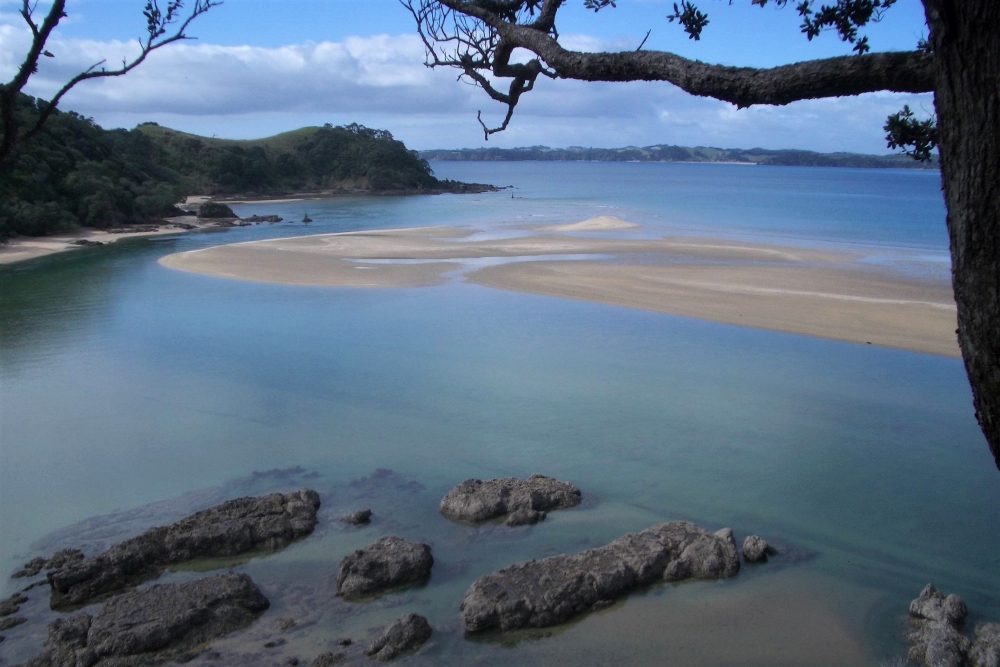 The entrance to Whananaki estuary.
The entrance to Whananaki estuary.
Scientists say estuaries are four times more productive in plant matter than fertile farmland, and 20 times more productive than the open sea. They grow a wide variety of plants which provide food for crustaceans, fish, birds and animals. In estuaries, most of the primary production occurs in the marshes and mudflats where wetland plants such as sedges and rushes, mangroves, bottom-dwelling algae, sea lettuce and seagrass grow in abundance.
Herbivores (plant eaters) only manage to eat a small part of the plants produced in the estuary. The rest – more than 90 percent - dies down to become food for a host of bacteria, fungi, protozoa and other micro-organisms. These in turn become food for bigger consumers such as crabs, bivalves, snails and fish. This is an example of the complicated food chains forming a food web in the estuary. Each organism is depending on others for survival, with all of them linked. Estuaries support up to five times as many bird species as an equivalent area of native bush.
A Northland study has shown that about 30 species of marine fish use estuaries at some stage of their life history and these sheltered havens are an important breeding and nursery area for snapper, flatfish, kahawai and whitebait. Many fish enter the estuary to take advantage of the rich food supply found in the seagrass beds and intertidal sandflats.
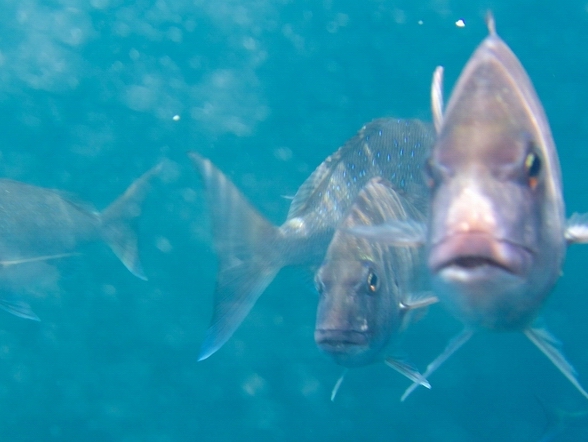 Snapper are just one of the many species to take advantage of the food supply found in estuaries.
Snapper are just one of the many species to take advantage of the food supply found in estuaries.
Estuaries and climate change
Coastal ecosystems including mangroves, saltmarshes and seagrass have a very important role to play in fighting climate change. They are the most efficient ecosystems for storing carbon on the planet and are therefore some of the most carbon-rich ecosystems on earth. They remove carbon from the atmosphere and oceans, storing it in plants and sediment where it is known as “blue carbon”. Coastal ecosystems are also the most threatened. Once they are degraded or destroyed, their blue carbon stores are released as carbon dioxide and contribute to global climate change. Around 83% of the world’s carbon is circulated through the ocean. Coastal habitats cover less than 2% of the total ocean area, yet account for about half of the total carbon hidden away in ocean sediments.
Dedicated conservation efforts can ensure that coastal ecosystems continue to play their role as long-term carbon sinks.
Where fresh and salt water mix
The mixing of fresh water and sea water is an important and distinct feature of the estuary. Fresh water, being lighter or less dense than salt water, will flow above the heavier sea water. In estuaries where large amounts of freshwater are discharged, a salt wedge is formed. This is a wedge-shaped, bottom layer of sea water, which is pushed up the estuary along the river bottom with each incoming high tide. The separation between fresh water and salt water can break down on an outgoing low tide when the waters move around more. Such conditions of mixing will create zones of brackish, or diluted, sea water - a common physical feature of estuaries.
Sediment traps
Because estuaries are located at the end of the freshwater drainage system, they are vulnerable to land-based activities and processes that occur within their catchments. Vegetation clearance for agriculture, forestry and urban land use have increased inputs of sediments, nutrients and metal contaminants to Northland’s estuaries. Furthermore, because of chemical reactions that take place when fresh water mixes with salt water, fine sediments flocculate (stick together) and these heavier sediment particles settle, often with chemicals attached or absorbed. This means estuarine environments are depositional areas and often become the ultimate sink for contaminants, rather than the open coast.
Our research shows that sedimentation rates before human arrival were 0.23mm per year and now they are higher at 2-6mm per year in order of magnitude, so this situation is worsening.
See the report on our sedimentation study in the Bay of Islands
Estuary plants
Estuary plants, predominately seagrass, rushes and mangroves help trap sediment and produce organic material, and which provide habitat for other animals.
Seagrass or eelgrass Zostera muelleri subsp. novazelandica (karepo/nana or Zostera)
Seagrass is an important component of estuaries and helps in the formation of saltmarshes. Seagrass is:
- the only flowering plant living in the sea, under the water
- a small, dark green, grassy plant with ribbon-like leaves
- an inhabitant of tidal flats
- a plant that forms large meadows from just above low tide level to full submersion in sea water
- a plant that stabilises sediment; allowing other plants to colonise higher ground beyond the seagrass meadows
- an important nursery area for young fish
- regenerating through projects that contribute to the regrowth of the plant.
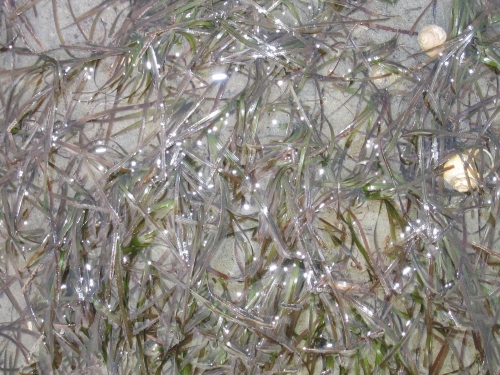 A close-up look at seagrass at low tide.
A close-up look at seagrass at low tide.
Glasswort Salicornia quinqueflora (ureure or Sarcocornia)
Glasswort is often the first plant to grow on the drier land beyond the seagrass beds in Northland estuaries. It adds to the fertility of the soil, cultivating conditions suitable for other plants to grow. Glasswort:
- is a succulent herb with jointed, green stems
- grows in salt meadows, often inter-mixed with other herbs like remuremu (Selliera radicans) and shore primrose, makoako (Samolus repens)
- it has a salty taste and sheep love it
- forms a low, dense, creeping mat
- has roots that help bind underlying muds and silts together
- has leaves and stems that encourage more sediment to settle.
Saltmarsh – rushes and sedges
Saltmarsh plants found at the heads of estuaries or on drier land, include sea rush (Juncus kraussii subsp. australiensis) and oioi or jointed wire rush (Apodasmia similis). They have wiry, erect stems and grow on estuary banks.
Sharp rush, Juncus acutus, is a large pest rush with leaves like spear points that can cause a nasty injury. Unfortunately, it is becoming more common in Northland harbours and estuaries and is spread by water or on machinery.
Alongside these plants, mangrove trees grow on estuary mudflats. Saltmarsh and mangrove areas provide feeding and breeding habitat for many birds, including pukeko, bittern and marsh crake.
As the tides ebb and flow between the stems of these salt marsh plants, the silt accumulates, and the salt marsh begins to teem with a changing community of animals. Instead of burrowing marine worms, there are earthworms, spiders, beetles and many other insects. Over several centuries, the stage is reached where the salt marsh is rarely covered by the tides. As the salinity lowers and drainage improves, coastal scrub such as raupo, flax, seedling trees such as manuka, cabbage trees and other plants begin to take over.
Further out, the seagrass continues to trap more silt and new saltmarshes are created.
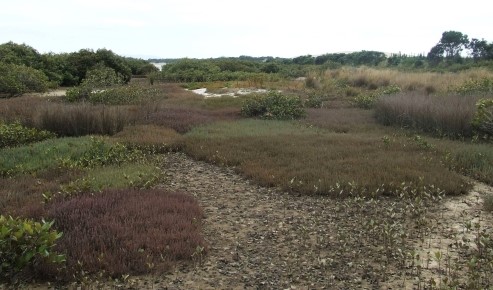 A saltmarsh at Mangawhai.
A saltmarsh at Mangawhai.
Mangroves (manawa or Avicennia marina subsp. australasica)
This mangrove species is New Zealand’s only species of mangrove and it is indigenous to New Zealand and Australia. New Zealand is the southern-most country where mangroves can grow. Mangroves are an important part of the estuarine habitat.
The leaves, fruit and twigs that drop into the water are a source of food. The breathing roots and overhanging branches are a nursery for fish, providing shelter and protection from predators. Mangroves provide feeding habitat for the rare bird the banded rail. Mangrove swamps (mangals) protect coastal areas and slow down tidal water so sediment is deposited as the tide comes in. Mangroves have:
- grey trunks, olive-coloured leaves and yellow flowers
- vertical breathing roots (pneumatophores) that take in air at low tide
- young plants (propagules) that drop into the sea where they grow or float away to start new colonies
- floating seeds that settle and take root in the mud.
What creatures live in estuaries?
Fish and shellfish
Studies done in Northland have found that many commercially important species of fish use estuaries at some stage of their life cycles, often as nursery areas for juvenile fish. These include flounder, mullet, rock fish, sole, kahawai, trevally, parore, red cod and gurnard. Freshwater eels and whitebait migrate through estuaries at least twice in their life cycle. Beds of shellfish, including pipis and cockles, are found in many estuaries and oysters are cultivated on marine farms in many northern bays and inlets.
Birds
Wading birds such as oystercatchers, herons, pied stilts and banded and New Zealand dotterels breed in and around Northland estuaries, feeding on invertebrates or digging for worms and shellfish in the tidal zone. The pied oystercatcher eats an average of 368 cockles per day in winter, and 261 per day in summer. Red-billed gulls love to steal the opened cockles left by the oystercatchers. Within the saltmarsh and mangroves, banded rail and the critically endangered Australasian bittern are feeding and breeding.
 A Pied stilt forages with a royal spoonbill at low tide.
A Pied stilt forages with a royal spoonbill at low tide.
Thousands of other wading birds come from the other side of the world to spend the summer in New Zealand estuaries, the most common being eastern bar-tailed godwits and lesser knots. Waders that breed in New Zealand include oystercatchers, herons, banded and New Zealand dotterels, pied stilts and wrybills.
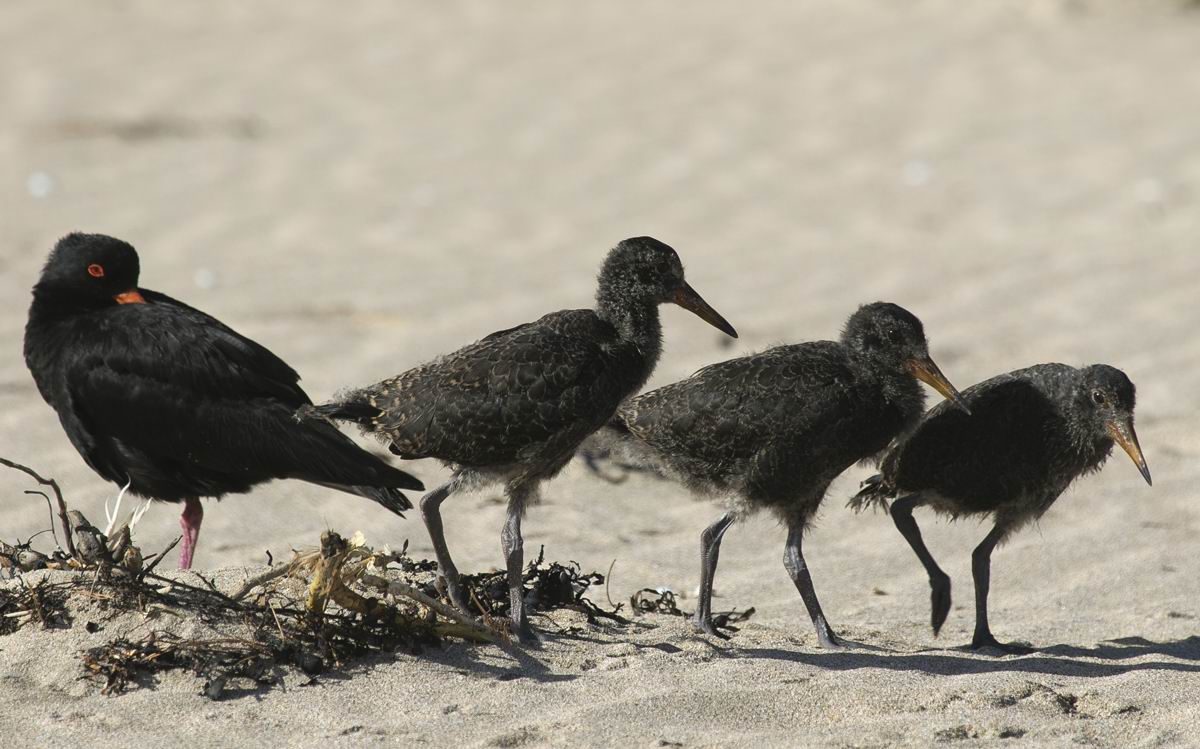 Oystercatchers are wading birds that breed in New Zealand.
Oystercatchers are wading birds that breed in New Zealand.
Shags, gulls, terns and kingfishers also make estuaries their home. In Northland the critically endangered NZ fairy tern makes its home at Mangawhai and Waipu estuaries.
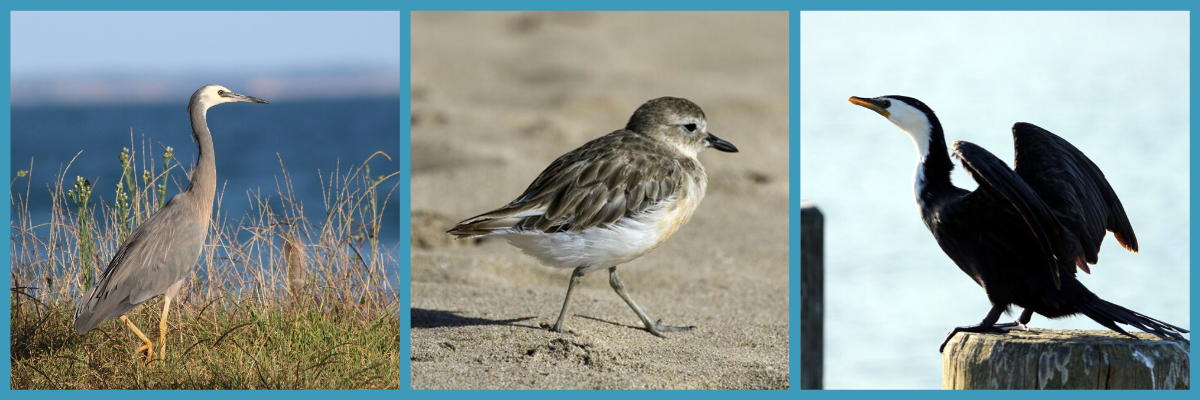
White-faced heron, NZ dotterel and little shag - these birds all make estuaries their home.
Other creatures
The tunnelling or short-eyed mud crab (Helice crassa), is found in the high tide zone of sheltered muddy shores around New Zealand. These crabs feed on the particles in mud when the tide is out, such as decomposing algae, and are in turn eaten by gulls, kingfishers and some coastal fish such as flounder and mullet. They dig themselves a burrow and only move out of the burrow to feed.
Mud snails live in the upper part of the inter-tidal zone, often among mangroves and salt marsh plants where they are only covered by the tide for a short time. They are muddy brown in colour, and about the same size and shape as a garden snail. Mud snails eat twice their own weight in mud every hour, extracting food material from it.
Freshwater fish
Native freshwater fish lay their eggs in estuarine waters and the young fish are swept out to sea before returning to swim up streams where they mature.
There are five species of whitebait (inanga) in New Zealand. They are juveniles of migratory galaxiids – inanga, koaro, and banded, giant and shortjaw kokopu. Inanga is the most commonly caught ‘whitebait’ (four of these inanga are classified by DOC as threatened). Juvenile common smelt are also caught.
The adult fish spawn in autumn, following summer migrations downstream to estuaries. The spawning grounds are on banks of tidal rivers, where slightly sticky eggs become attached to vegetation at high tide. At the next high tide, the whitebait hatch and float out to sea. In Spring they return as whitebait, possibly to the same estuaries, and migrate upstream.
Eels (tuna) don’t lay eggs in estuarine waters – they travel to the Pacific/Tonga trench and spawn there. The larvae/leptocephali drift back to New Zealand where they change into glass eels before entering estuaries, developing into elvers and travelling upstream to the rivers to grow as eels.
The free passage of native fish between streams and estuaries can be seriously affected if culverts for developments such as causeways and roads are badly designed. Fish passes are increasingly being constructed as part of such works, so these creatures can migrate safely.
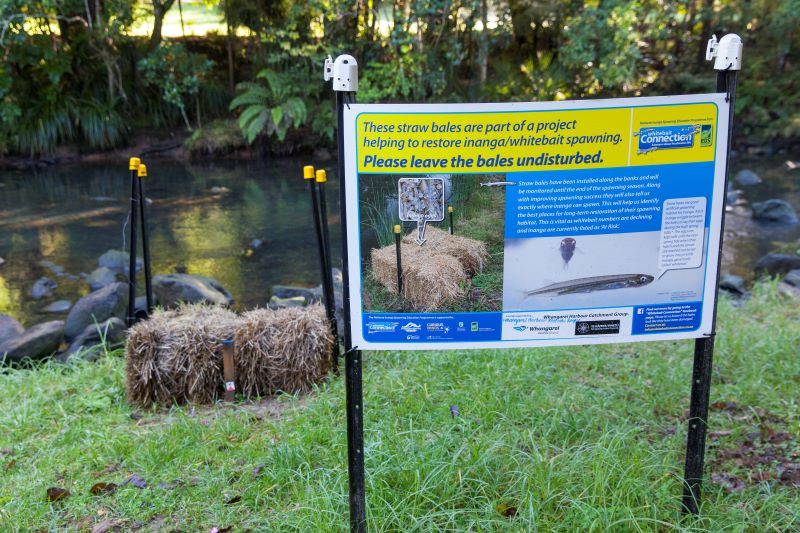 A project involving Whitebait Connection to create artificial spawning habitats and egg nurseries for an at-risk native fish, inanga (whitebait species).
A project involving Whitebait Connection to create artificial spawning habitats and egg nurseries for an at-risk native fish, inanga (whitebait species).
Read more about Whitebait Connection's award-winning project
Importance to Māori
Estuaries and tidal areas have high value to Māori people as a source of identity – a sense of place. They provide fish and shellfish, birds, flax and other traditional items. Māori names for some plants and animals of coastal wetlands are:
- Bittern - matuku
- Cabbage tree - tī kōuka
- Cockle - tuangi
- Crab - paapaka
- Eel - tuna
- Flax - harakeke
- Flounder - patiki
- Kingfisher - kotāre
- Mangrove - manawa (this means ‘to breathe’ and refers to the plant’s aerial roots
- Mud snail - titiko
- Mussel - kutai
- NZ dotterel - tūturiwhatu, tuturiwhatu, tuturiwhatu pukunui, rako
- NZ pied oystercatcher - Tōrea, torea
- Pied stilt - poaka
- Reef heron - matuku moana
- Rock oyster - tio reperepe
- Rushes - wiwi
- Shellfish - kaeo (or) seafood kaimoana
- Variable oystercatcher - Tōrea, torea, tōrea pangoa, torea pango, toreapango, tōrea tai, torea tai
- White heron - kōtuku, kotuku
- Whitebait - inanga
- White-faced heron - matuku, matuku moana
- Yellow-eyed mullet - aua
Impact on estuaries
The easy access of estuaries means that people and industry can have a major impact. The direct effects of humans include the over-harvesting of organisms such as snails, bivalves, crabs and flounder for eating or use as bait. The flow-on effect of excessive harvesting on the complicated food webs in estuaries is not yet well known.
Many estuaries have been significantly changed by port or road construction, flood prevention measures or reclamation. Ships flushing ballast water have, in some cases, introduced pests that may threaten the balance of estuary ecosystems.
Types of pollution include:
- leached nutrients from fertiliser
- pesticides
- oils and dispersants
- urban runoff, which contains heavy metals
- anti-fouling paints from recreational boats and the ship industry
- heavy metals and PCBs from old dump sites and roadsides
- oil and bilge spills at marinas, boat ramps or refuelling depots
- sewage from leaks or floods in sewers or inadequate sewerage systems in coastal settlements
- litter and microplastics
Heavy metals, including zinc, copper, lead, iron and chromium can be dangerous pollutants if excessive amounts leach and accumulate into the estuary. Once they enter the food chain, they can become concentrated in the tissues of marine animals and become dangerous for people to eat.
Stormwater
Most water eventually drains to the sea from the land. Whenever there is heavy rainfall, the drainage systems in cities, towns and roadsides direct the water through pipes and into the sea. Any pollution and debris the stormwater picks up along the way ends up in the sea as well. In some places in Northland, it is not safe to swim or collect shellfish in estuaries straight after heavy rainfall because of all the pollutants that have been deposited in the water from the land and roadsides.
Many shellfish that live in estuaries, such as cockles, are filter feeders that filter through water to get their food. If there is pollution in the water, they tend to filter that as well, meaning they can become unsafe for people to eat. Shellfish help improve water clarity by filtering sediment out of the water. However, if there is too much sediment or pollution, the shellfish will die or move out. This makes the sediment problem worse because there are no shellfish left to filter the water.
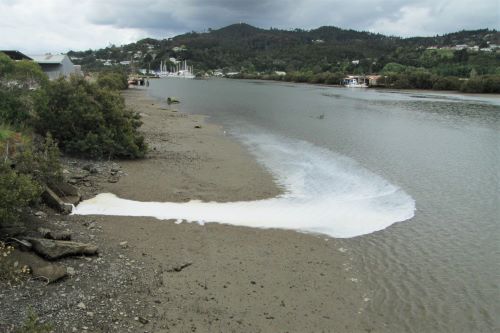 Paint discharging from a stormwater outlet - what goes down the drain ends up in our streams, rivers and estuaries and harbours.
Paint discharging from a stormwater outlet - what goes down the drain ends up in our streams, rivers and estuaries and harbours.
Find out how you can keep pollutants out of our stormwater systems
Threats to our estuaries
Vessels coming to New Zealand can carry marine pests via hitchhiking on hulls or in ballast (water that ships carry to balance). Ships flushing ballast water have, in some cases, introduced pests that may threaten the balance of estuary ecosystems and ruin our enjoyment of them.
Biosecurity New Zealand has strict rules in place to manage the risks of vessels arriving in New Zealand, but it’s important to have regional rules in place as well to reduce the spread of pests already established in other parts of the country.
New hull maintenance and cleaning rules to manage the movement of fouled vessels in Northland apply under the Marine Pathway Plan. A clean hull prevents marine pests from spreading into new places and infecting our valuable marine environment. The rules require hulls to be cleaned before moving a boat, not after. Hulls coated with caustic paints must be hauled-out to prevent the release of harmful biocide chemicals during cleaning.
For the full rules, visit www.nrc.govt.nz/boatcleaning
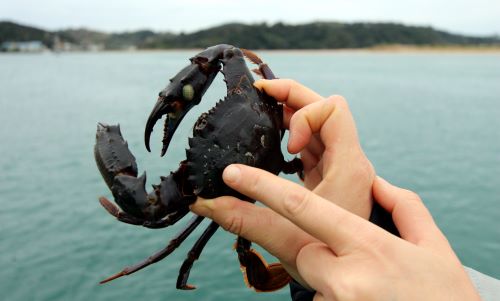 The Asian paddle crab - a nasty marine invader that can be found in the Ngunguru estuary, Kaipara and Whangārei harbours and the Bay of Islands.
The Asian paddle crab - a nasty marine invader that can be found in the Ngunguru estuary, Kaipara and Whangārei harbours and the Bay of Islands.
Find out more about Asian paddle crab and other marine pests in our Pest Control Hub
Invasive organisms are another threat. Unwanted foreign organisms in New Zealand waters include:
- Australian droplet tunicate, (beach slime) is a rapidly growing sea squirt that competes with native species for space and food
- Mediterranean fanworm, present in Whangārei harbour in dense beds that smother other species and foul marine farms and boats. This foreign invader has the potential to spread to other harbours
- Asian paddle crab, this aggressive species has the potential to compete with native crabs for habitat and food. It may consumer shellfish species that are culturally and economically important and can inflict a vicious bite when disturbed
- Undaria seaweed, sometimes known as Japanese kelp, this seaweed can change the structure of ecosystems and may become a nuisance for marine farms
- Japanese mantis shrimp, preys on shrimps, crabs and thin-shelled molluscs, can alter habitats by burrowing, and may compete for food and space with other crustaceans.
- Pyura sea squirt, has the potential to significantly alter the structure and composition of intertidal communities. Dense mats have already engulfed and displaced native green-lipped mussel beds in some areas of the Far North.
- Styela sea squirt, competes for space and food with native and aquaculture species including mussels and oysters. It can also be a nuisance by fouling marine farming lines, vessel hulls, and other structures.
The most feared potential pests (not currently found in New Zealand) are:
- European shore (or green) crab, attacks a wide range of sea creatures and threatens scallop and mussel industries
- Northern Pacific seastar, threatens marine biodiversity
- Chinese mitten crab, threatens marine communities and freshwater riverbanks. The crab digs holes into riverbanks, causing them to collapse. It also carries a lung fluke worm which can infect people
- Asian clams, smother other shellfish by reaching populations of 25,000 per square metre
- Aquarium Caulerpa (green aquarium seaweed), smothers all other plant life in shallow water. This seaweed is used in aquariums.
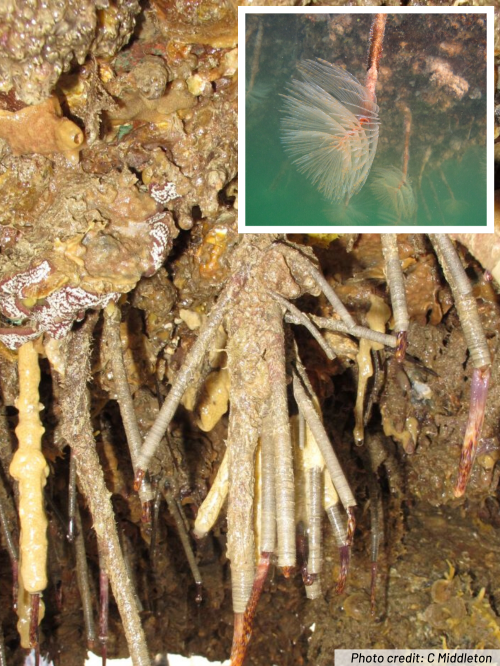 Mediterranean fanworm is an invasive species that hitch-hikes on the hulls of boats and spreads around our waterways.
Mediterranean fanworm is an invasive species that hitch-hikes on the hulls of boats and spreads around our waterways.
The NRC's role
The Proposed Regional Plan sets out new rules and policies for how people use fresh water, land, air and the coast in Northland. The new regional plan will replace the council’s three existing regional plans It is the updated rulebook for how Northland’s water, air, soil and coast are used and managed.
Go to the Proposed Regional Plan page
It covers a broad range of activities, including proposed rules for use and development in the coastal marine area, water uses and discharges to air, land and water, new limits on taking water from rivers, lakes and aquifers, permissions for mangrove removal and new stock exclusion rules for rives, drains, wetlands and lakes.
The regional council is responsible for enforcing the rules in the plan, issuing resource consents, monitoring consents, investigating incidents and monitoring the state of the environment.
What can you do?
Shorebirds |Coastal dunes | plants
What you can do:
- Look after coastal dunes/plants
- Watch out for, and give shorebirds their space especially during breeding season
Stormwater
Stormwater drains help carry away the rain water that runs off places like roads, roof tops, yards, car parks and footpaths. Most stormwater isn't treated so what goes down the drain ends up in our streams, rivers and harbours.
What you can do:
- Don't dispose of unwanted household chemicals, paint or oil down the stormwater system
- When washing your car, try to do it on a lawn where the wastewater can soak into the grass
- Keep your vehicle free of leaks and dispose of old oil at authorised disposal areas. Do your oil change where accidental leaks can be cleaned up easily and won’t run into a stormwater drain
- If you are a landowner or business, ensure that stormwater from your site receives the appropriate treatment. Keep sealed surfaces clear of dirt and sediment build-up. Ensure that all chemicals are labelled correctly and stored appropriately. Keep a spill kit on site in case there is an accidental spill
- If you have a spill, which cannot be safely absorbed with kitty litter or sawdust, report it to the regional council's Environmental Hotline (0800 504 639) or the NZ Fire Service.
For more information visit: www.nrc.govt.nz/waterpublications
Litter
Litter is easily swept into stormwater drains, and some of it, like plastic, remains in the environments for many lifetimes. It can harm marine animals if they eat it or get tangled in it. It also ends up on our beaches and along our streams and rivers.
What you can do:
- Dispose of any litter responsibly
Boat maintenance
- Antifouling paint contains copper, zinc, organotin compounds or other biocides, which impede the growth of marine organisms, so by their very nature they are harmful to marine animals and the environment.
What you can do:
- Boat maintenance, especially cleaning and painting the hull of a vessel, should be conducted at authorised facilities and care should be taken to contain all contaminants. Wet sanding should only be undertaken on sealed surfaces and drop sheets should be used when applying paint.
- Anodes, used to protect a boat's hull from corrosion, often contain zinc. Avoid water-blasting anodes and dispose of them appropriately.
Pathogens (something that can cause a disease)
What you can do:
- Untreated boat sewage must be discharged well outside any harbour or at an authorised pump-out facility
- If you have a septic tank and an on-site effluent treatment system, ensure that the system is maintained and operating effectively. For more information about septic tanks and on-site effluent treatment and disposal systems visit: www.nrc.govt.nz/waterpublications
- Municipal wastewater treatment systems can become inundated by stormwater during heavy rainfall events. Ensure your domestic sewer gully trap is raised above ground level to stop stormwater flowing in
- Keep livestock out of waterways and the coastal marine area.
If you see any potential pollution, report it to our 24/7 Environmental Hotline - free-phone 0800 504 639.
